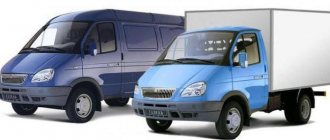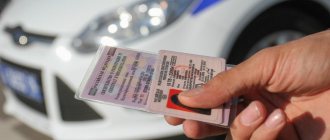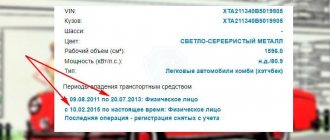AutoYurait.rf / Registration and accounting
Back
Published: November 22, 2018
Reading time: 16 min
0
855
Classification of vehicles on the territory of the Russian Federation is carried out in accordance with the Decision of the Customs Union Commission dated December 09, 2011 N 877 “On the adoption of the technical regulations of the Customs Union “On the safety of wheeled vehicles” (TR CU 018/2011). This regulation provides for the division of cars into categories, which have a letter designation: L, M, N, O.
- L - motor vehicles Mopeds, motorbikes, mokikis
- Motorcycles, scooters, tricycles
- Quadricycles
- Cars
Category "Lx"
Category “L” is usually divided according to the following criteria:
- “L1” is a two-wheeled vehicle that does not exceed 50 kilometers per hour. When an internal combustion engine is installed, its volume should not be more than 50 cm3. And when the electric motor is installed, its volume should not be more than 4 kW;
- "L2" is a three-wheeled vehicle that accelerates to no more than 50 kilometers per hour. With an installed internal combustion engine of no more than 50 cm3 or an electric motor of no more than 4 kW. These categories include mopeds and motorbikes. It's quite easy to differentiate between them;
- “L3” - vehicles with a maximum permitted speed of over 50 kilometers per hour with any engine installed;
- “L4” is a vehicle with wheels symmetrical to the transport plane. The maximum speed is more than 50 kilometers per hour, and the engine capacity is over 50 cm3;
- "L5" is a symmetrical vehicle that accelerates over 50 kilometers per hour. The engine capacity is more than 50 cm3;
- “L6” is a four-wheeled vehicle weighing no more than 350 kilograms. The mass of the battery is not taken into account. Transport should not exceed a speed of 50 kilometers per hour. In this case, the power of the internal combustion engine should not be more than 50 cm3, and the power of the electric motor should not be more than 4 kW;
- “L7” – other four-wheeled vehicles not included in the L6 category, weighing no more than 400 kilograms. For cargo vehicles 550 kilograms without battery. The engine capacity should not be more than 15 kW.
Motorcycles, scooters, tricycles
The traffic rules also provide for other subcategories for vehicles with limited characteristics:
- L3 - vehicles equipped with two wheels, the volume of the internal combustion engine of which should not be higher than 50 cm3. The maximum speed allowed by their design characteristics is 50 km/h;
- L4 – mechanisms for movement, equipped with three wheels, which are located asymmetrically with respect to the longitudinal line of the vehicle. The working volume of their internal combustion engines is no more than 50 cm3. Structurally permissible maximum speed is 50 km/h;
- L5 – category having characteristics identical to L4;
The main difference between these categories is the distance between the points of contact of the wheels with the road surface. If this value does not exceed 46 cm, the vehicle belongs to category L3.
To drive vehicles of subcategories L3-L5, you must obtain a driver's license with open category A.
ATVs
ATVs are vehicles belonging to subcategory L6. Their maximum weight, without additional cargo, should not exceed 350 kg. The weight of the batteries is not taken into account if the vehicle is powered by an electric motor. For such units, the maximum permissible speed is 50 km/h.
Subcategory L7 has similar parameters, with the exception of the maximum unladen weight. This value should not exceed 400 kg. for ordinary vehicles and 550 for trucks.
To operate an ATV of subcategory L6, you must open category M. For those ATVs that have increased power parameters, you will need to open category B1.
Category "Mx"
Category M includes vehicles that allow the transportation of citizens. They are separated using the following:
- “M1” - the number of passenger seats is no more than eight. Usually this category is in greatest demand among citizens;
- “M2” - the number of passenger seats is more than 8, and the total weight does not exceed 5 tons;
- “M3” - the number of passenger seats is more than 8, and the total weight exceeds 5 tons.
The “M1” category includes ordinary passenger cars, which almost every family owns. The categories “M2” and “M3” designate trolleybuses or buses, which are divided depending on their weight. If it is less than 5 tone, then “M2”, and if more, then “M3”.
CATEGORY M – PASSENGER VEHICLES
Category M is assigned to all types of vehicles that have at least four wheels and are intended for the transport of passengers.
Cars
M1 – vehicles used for the transport of passengers and having, in addition to the driver’s seat, no more than eight seats. Almost all brands of passenger cars fall into the M1 category. The exception is for models in which the maximum weight of transported cargo allowed by the design exceeds the total conventional weight of passengers (68 kg multiplied by the number of passenger seats). In this case, the car is assigned category N. A passenger car is inspected once every 2 years if the vehicle is over 3 years old, annually if the vehicle is over 7 years old or is intended for driving lessons. Up to 3 years, including the year of manufacture, no technical inspection is required. If the car is used as a taxi, maintenance must be done every six months.
Correspondence of vehicle categories and rights
Drivers often try to find out what category of license they need to have to drive a particular vehicle.
- to drive a passenger vehicle of category "M1" you will need the designation "B". Citizens need this category of license to drive a car every day. It is important to know that the “M1” category does not include trucks that fall under the “B” designation on their license;
- You can drive vehicles of categories “M2” and “M3” with a driver’s license with the designation “D”;
- vehicles falling under category “N1” can be driven with the common designation “B” on the driver’s license;
- to operate cars “N2” and “N3” you need category “C”;
- driving a car with a trailer weighing no more than 750 kilograms is possible with the usual category “B”;
- and for the categories “O1”, “O2”, “O3” the designations “E” to “B”, “E” to “C” and “E” to “D” on the license are suitable;
- To drive a vehicle of category “L1” - “L2”, you need category “M” on your driver’s license;
- You can drive a vehicle of category “L3” - “L5” with the designation “A”;
- You can legally drive a vehicle “L6” - “L7” if you own category “B1”.
When choosing your vehicle, be sure to check whether you have the ability to drive it. You can do this by looking at the designations that are on your driver’s license. If your category does not allow you to drive a certain vehicle, then its operation in the future may lead to the deprivation of your driver's license. Given such a serious punishment, we need to take this moment extremely seriously. Remember, you can also receive a punishment if you transfer your vehicle to a citizen whose category of rights does not allow him to drive this car.
Category G - off-road vehicles
8.1 Definition
Off-road vehicles include vehicles of categories M and N that meet the requirements of this section, compliance with which is checked under the conditions defined in 8.2 and 8.3.
8.1.1 Vehicles of category N1, the maximum weight of which is not more than 2 tons, as well as vehicles of category M1 are considered off-road vehicles if they have:
- at least one front and one rear axle, the design of which allows them to be driven simultaneously, including vehicles in which the drive of one axle can be switched off;
- at least one differential locking mechanism or one mechanism of similar operation, and
- if they (in the case of a single vehicle) can negotiate a 30% grade. In addition, they must satisfy at least five of the six requirements below:
- The approach angle must be at least 25°;
- The departure angle must be at least 20°;
- the longitudinal pass angle must be at least 20°;
- ground clearance under the front axle must be at least 180 mm;
- ground clearance under the rear axle must be at least 180 mm;
- The center ground clearance must be at least 200 mm.
8.1.2 Vehicles of category N1, the maximum weight of which is over 2 tons, or vehicles of categories N2, M2 or M3, the maximum weight of which is not more than 12 tons, are considered off-road vehicles if their design ensures simultaneous drive of all wheels, including transport wheels means in which the drive of one axis can be switched off, or if they satisfy the following requirements:
- at least one front and one rear axle are simultaneously driven, including vehicles in which the drive of one axle can be switched off;
- there is at least one differential locking mechanism or one mechanism of similar action;
- vehicles (in the case of a single vehicle) can climb 25%.
8.1.3 Vehicles of category M3, the maximum mass of which is over 12 tons, and vehicles of category N3 are considered off-road vehicles if they have simultaneous drive of all wheels, including vehicles in which the drive of one axle can be switched off, or if the following are observed requirements:
a) at least half of the axles are driven;
b) there is at least one differential locking mechanism or one mechanism of similar action;
c) vehicles (in the case of a single vehicle) can climb 25%;
d) at least four of the following six requirements are met:
- The approach angle must be at least 25°;
- The departure angle must be at least 25°;
- the longitudinal pass angle must be at least 25°;
- ground clearance under the front axle must be at least 250 mm;
- the center ground clearance must be at least 300 mm;
- The ground clearance under the rear axle must be at least 250 mm.
8.2 Load and test conditions
8.2.1 Vehicles of category N1, the maximum weight of which is not more than 2 tons, and vehicles of category M1 must be in running order, i.e. filled with coolant, lubricant, fuel, equipped with tools and a spare wheel; The standard driver weight, assumed to be 75 kg, must also be taken into account.
8.2.2 Motor vehicles not specified in 8.2.1 must be loaded to the technically permissible maximum weight established by the manufacturer.
8.2.3 The ability of a vehicle to overcome a rise of a set value (25% or 30%) is confirmed by a calculation method.
However, in exceptional cases, the technical services may require the presentation of a vehicle of the appropriate type for the actual test.
8.2.4 When measuring the angles of the front and rear overhang, as well as the longitudinal angle of flotation, wheel protective devices are not taken into account.
8.3 Definitions and drawings regarding front and rear overhang angles, as well as longitudinal flotation angle and ground clearance
8.3.1 approach angle: According to international standard ISO 612 [1], clause 6.10. See Figure 1.
Picture 1
8.3.2 departure angle: According to international standard ISO 612, paragraph 6.11. See Figure 2.
Figure 2
8.3.3 longitudinal flotation angle: According to international standard ISO 612, paragraph 6.9. See Figure 3.
Figure 3
8.3.4 Center ground clearance: The shortest distance between the reference plane and the lowest point of the vehicle located on its rigid element. Multi-axle bogies are treated as one axle. See Figure 4.
Figure 4
8.3.5 ground clearance under one axle: The distance between the top point of a circular arc passing through the centers of the contact patches of the tires of one axle (in the case of dual tires - the tires of the inner wheels of the axle) and touching the lowest point of the vehicle, rigidly fixed between the wheels, and the supporting flat. See Figure 5.
Figure 5
No rigid part of the vehicle shall be located, wholly or partially, within the shaded area of the drawing.
Ground clearances under several axles are indicated, where appropriate, based on the sequence of their location, for example “280/250/250”.










